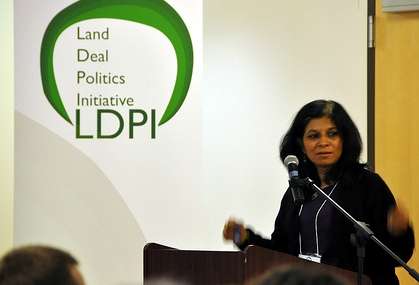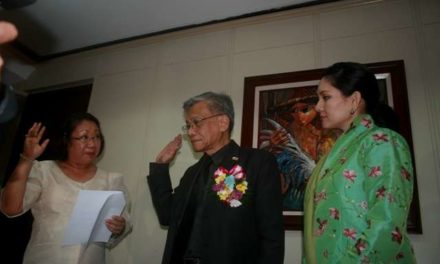Cornell University, 17 October 2012
Shalmali Guttal, Focus on the Global South
Thank you very much to the LDPI for inviting me to give this address. I am with Focus on the Global South, and also representing the Land Research Action Network (LRAN). I would like to share with you some thoughts about what I consider to be important issues for this conference.
“Naming” the Problem
The first issue is the challenge of finding an appropriate name for this renewed surge in land grabbing. I understand that there is now an ongoing debate in academia and among global policy makers about how land grabbing should be defined and described.
In my view, the term “land grabbing,” does not adequately express or encapsulate the range and extent of what is being grabbed, stolen, lost and destroyed. Here is a quick list: land, water, forests, eco-systems, landscapes, food sources, natural and agro-biodiversity (seeds, breeds, species), livelihoods, labour, knowledge, community, culture, values, security, agency, power and futures. And there is still more.
The reality and experience of land grabbing on the ground is dispossession and destruction on a massive scale, which are comprehensive and systematic. This dispossession and destruction are not accidental by-products or aberrations of an otherwise viable model of land and natural resource use. Rather, they are purposive acts aimed at consolidating and concentrating wealth, resources and power in the hands of a select few.
The modes of dispossession are multiple and increasingly inventive, and justified in official policy through a re-valuing of nature and nature’s elements to serve markets. The “green economy” framework by the United Nations Environment programme (UNEP) is shocking: all of nature’s elements and functions are called “natural capital,” and the strategy is to determine appropriate values for them and put them in the markets to achieve economic growth—“green growth.” This will be done for land, forests, soil, water and water-catchment, bio-diversity, carbon sequestration—any and all elements and functions of nature. And this type of grabbing is supposedly in service of environmental sustainability as well.
Asymmetries of Power
Another major issue is what is happening to the abilities of peoples and communities to protect their lands and resources. People and communities who are threatened with dispossession are fighting back in as many ways as they can: legally, through public actions, mass demonstrations and protests, standing in front of bull-dozers, etc.
But the reactions or pushback from grabbers and investors are very strong and hard. The investors have the state and state apparatus on their side, including the police and military, and permission to have private armed security. It is absolutely crucial to recognize the role played by the state—the kind of land deals we see today cannot happen without the active involvement of the state. But this is not simply a situation of corrupt governments as many like to claim. This is the kind of state that capital needs to secure control over resources, and the state and capital work together in complex ways to serve one another.
Those who stand up against the grabbers and investors are frequently threatened, intimidated, sued and incarcerated; many are branded as anti-nation dissidents; and still others are disappeared or killed. Chut Vuthy from Cambodia, Abdul Karim from Bangladesh, Gilbert Paborada from the Philippines, and Cristian Ferreyra and Miguel Galvan from Argentina, are only a few of the known names. There are many others who are injured, disappeared or killed, whose names do not make it to the press and media reports, and whose families are intimidated into silence. Entire communities are threatened with repercussions by state and not state actors if they resist the theft of their lands and resources.
There are successful struggles against land grabbing, but the struggles are getting more intense and difficult:
- Resisting communities get fractured because of the threats and intimidation;
- Many families are evicted outright and have no place to live;
- Those who stay on to fight pay a high price for resistance; the burden of making a daily living, feeding their families AND protecting their lands, forests and water sources becomes too much; they get exhausted and say “you fight;” they accept whatever compensation they can get and move away;
- In communities that lose part (not all) of their lands, many with the capacity to work migrate seasonally to find other jobs – which are also poorly paid, but they don’t have the luxury to choose;
As a result, the resistance on the ground starts thinning out. The mass of people left behind are not enough to pose a serious challenge to the grabbers and investors, who then claim that there are no conflicts associated with their deals.
Also, there are many different spaces for struggles, which are not easy to link. Struggle locations are usually geographically separated and these distances are not easy to cross; there are also boundaries of language, gender, culture, and politics. Social movements, local networks and their allies try to link struggles with one another but they do not have enough resources to do this on a continuing basis—so it is a real challenge to build broad based struggle platforms.
Many governments and international institutions claim that they have put in place initiatives for consultation and conflict resolution. But these generally result in outcomes in favour of the grabbers, not communities—compromises always disproportionately tilt towards those with more power. The situation is almost like a war of attrition with periods/moments of intense battles. Three important factors here:
- The grabbers have more resources than local communities and can survive the fights longer
- Ideology plays a strong role here: local-national NGOs, academics and even affected communities at times are reluctant to challenge the development model that facilitates these deals. There is a false consciousness that has been built up through policy dialogues, consultations, research, etc., about how development equals investment, and how this is needed for the well being of all people. And public opinion does not challenge these assumptions or question who really has rights to what, who should make decisions about what, etc.
- There is a complete capture of the state, and state institutions and mechanisms by the grabbers. In many places you don’t know where the state ends and the corporation begins.
Transparency
This bring me to the third important issue, that of transparency in land deals, which seems to have become a popular demand among many organisations involved in land related advocacy.
We have enough evidence now to show the destruction caused by land grabbing. But while the body of research on the issue is growing, support for organizing against land grabbing is not growing. Knowledge about land grabbing is not translating into the policy, legal or even “soft” power to stop and prevent it.
It would appear that in academia and policy circles and among development donors and practitioners, there is greater support for studying and writing about land grabbing than for building resistance against it. So the gap between knowledge and theory on one hand, and struggles and actions on the other, is increasing.
Equally, at all levels (local-global) there is little challenge to the myth that the current forms of investment are needed for development. The emphasis instead is on transparency of land deals—as though knowing who is coming to claim one’s lands is enough to stop them from doing it. Advocacy organisations, international agencies and even many governments are promoting transparency initiatives, implicit in which is the belief that investments and land deals can somehow be made “responsible” or “win-win” if information is made available to affected communities about the deal or investment.
Of course, affected communities need and must have access to all relevant information about investment and land use plans. But information must be must be accompanied by the ability to take action. The right to know is a crucial, but not sufficient condition to make investments and land deals fair or acceptable. Transparent land grabbing is still land grabbing. Affected communities must be able to take participate in making decisions that so deeply affect their lives and futures, and take effective action as and when needed. Without this, transparency is at best a diversion, and at worst an insidious trap, like “good governance” in World Bank-IMF designed structural adjustment programmes and PRSPs.
There is no way to sanitize the destruction of social and natural landscapes—it is just plain unacceptable. We should remember that often, unless action is taken within a particular time frame, the destruction is irreversible. We have to support resistance and action, not compromise initiatives.
One example of how transparency can lead to action is if academics would examine how their pension funds are being invested, and what investments their endowments are coming from. There is a lot of information now about how finance corporations are creating new “assets classes” that are based on land, forests, water and food production. We can demand that our pension fund managers disclose how our money is being invested, trace the source of our endowments and raise our voice against investments that are resulting in dispossessing local people elsewhere from their lands, livelihoods and rights.
In closing, I would like to make an appeal to all the academics and researchers here to please join and support the struggles of peoples and communities to defend their lands and lives. There are many struggles all over the world and you can come in anywhere and at any level. What is important is that you join the struggles, and the knowledge you produce be converted to power in the hands of peoples and communities to defend their lands and lives, and build better futures.
Thank you.








